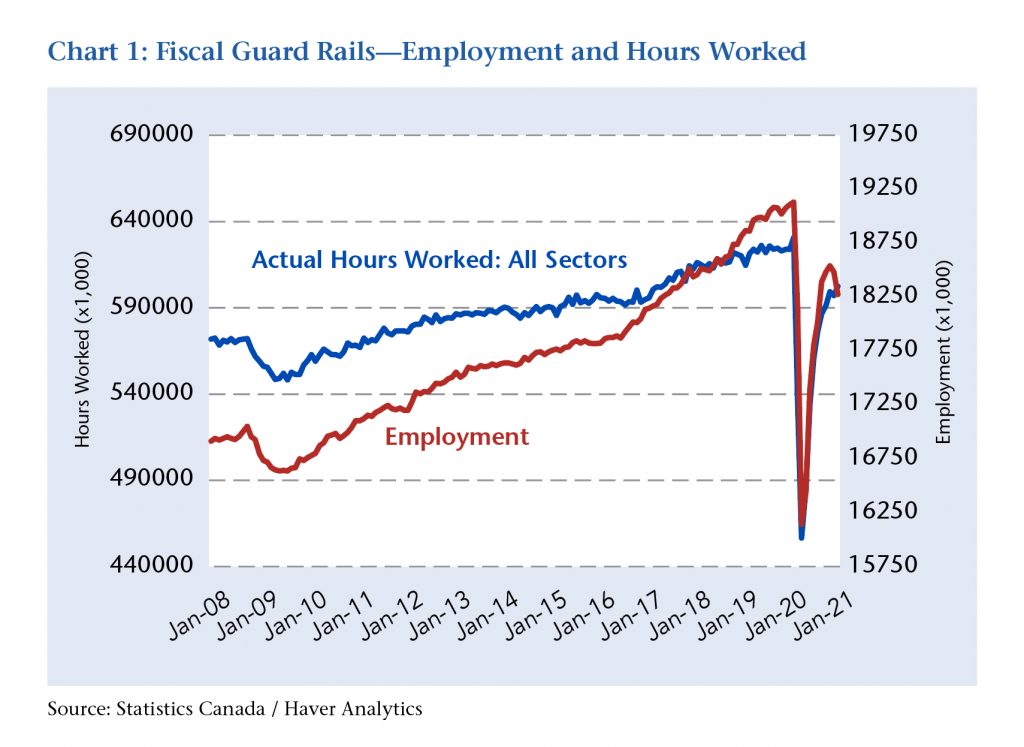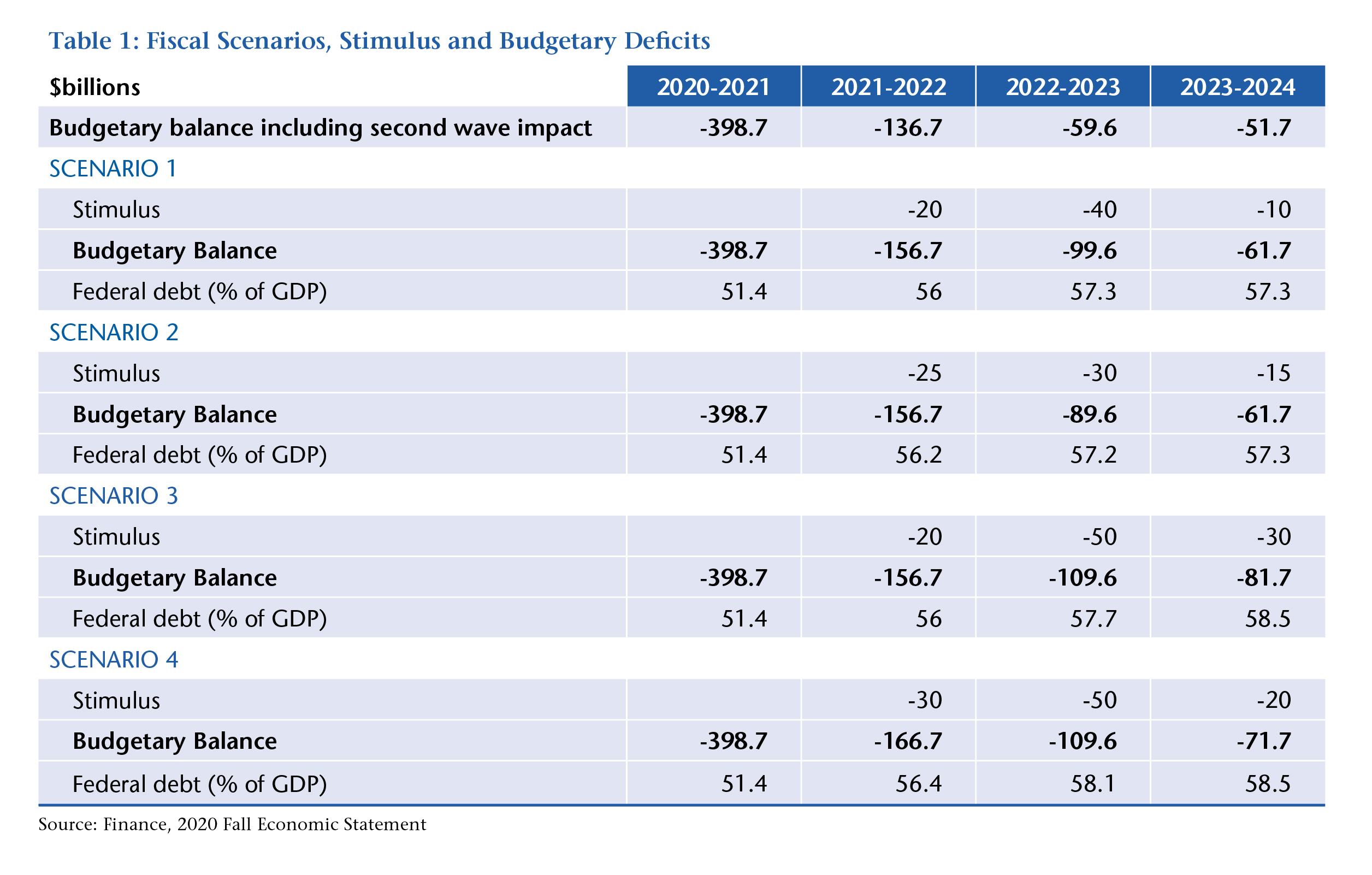Fiscal Policy: Relief, Recovery and Reset
In normal times, federal budget calculations based on finding a balance among the demands of the economy, the values of the government, the needs of constituencies and political timing. The context of the Trudeau government’s 2021 budget has skewed those considerations by superimposing the health and economic crisis of a deadly pandemic and the exigencies of a minority Parliament over them. Institute of Fiscal Studies and Democracy founder and CEO Kevin Page and his co-authors break down the budget juggle for an exceptional year.
Kevin Page, Donya Ashnaei and Elo Mamoh
Finance Minister Chrystia Freeland launched pre-budget consultations in mid-January with the comment that Budget 2021 “Will be the most significant one of our lifetimes.” It is a bold and unusual move for public finance officials to raise expectations in an environment of economic hardship, fear and uncertainty. What will be the role of fiscal policy, the purview of the Finance Minister, to meet this unprecedented moment?
Many share a feeling that we are living in consequential times. In this regard, Budget 2021 will be important, whether it succeeds or fails to bring about policy changes to promote a post-pandemic recovery. Of course, we want global solutions to global challenges. We want Canada to succeed.
The Israeli historian Yuval Harari framed our collective circumstances in frank language:
“Humankind is now facing a global crisis. Perhaps the biggest crisis of our generation. The decisions people and governments take will probably shape the world for years to come. They will shape not just our health care systems but also our economy, politics and culture. When choosing between alternatives, we should ask ourselves not only how to overcome the immediate threat, but also what kind of world we will inhabit once the storm passes.”
The stakes for Budget 2021 are high. Fiscal policy must chart a path for relief, recovery and reset.
Governments have used economic lockdowns and social distancing measures to reduce COVID-19 infections and deaths. Fiscal policy has been used to support households and businesses during the pandemic. Relief must continue as infections spread, new variants develop and the vaccination process rolls out. The government’s recent proposed extension for the Canada Recovery Benefit is such an example.
By almost any benchmark, the Canadian economy is weak. Notwithstanding a rebound since the pandemic-induced economic lockdown in the second quarter of 2020, real GDP is down 2.8 percent in November 2020 on a year-over-year basis, with declines in both the goods and services sector. The unemployment rate sits at 9.4 percent in January 2021. Prospects for the recovery are largely tied to the evolution of the virus and our public health management. In a world of low interest rates and significant post-pandemic economic scarring, fiscal policy will be used to support a return to potential output and full employment.
The pandemic reminded us of the power of mother nature and the importance of science in addressing public policy challenges. Climate change scientists tell us that the next few decades will be critical in addressing the problems of global warming. Fiscal policy must be used to finance the shift to a greener economy in a way that promotes economic adjustment, inclusion and resilience and protects fiscal sovereignty for future generations.
Freeland faces a number of challenges in crafting a fiscal policy strategy that guides our country from pandemic relief to recovery to reset. The government will be judged on how they address these challenges.
One, the challenge of building confidence and trust. It will be Freeland’s first budget. It will be the first federal budget in two years—a record period of time to go without a budget.
Two, the challenge of policy change. The budget must lay the fiscal planning framework for complex and structural changes to public infrastructure to reduce carbon emissions and to our socio-economic systems to promote opportunity and adjustment and reduce disparity.
Three, the challenge of cooperation. The federal government must build policy and governance bridges with the international community, other levels of government, and our First Nations people. You cannot solve global problems without cooperation.
 Four, the challenge of fiscal strategy and management. The current Liberal government does not have strong bona fides in fiscal policy. They have largely managed without real budgetary constraints that drive policy choices and trade-offs and protect fiscal room for future generations.
Four, the challenge of fiscal strategy and management. The current Liberal government does not have strong bona fides in fiscal policy. They have largely managed without real budgetary constraints that drive policy choices and trade-offs and protect fiscal room for future generations.
Roger Martin, the former dean of the Rotman Business School at the University of Toronto, said that strategy is the “process of thinking through what it would take to achieve what you want and then assessing whether it’s realistic to try… it should be outside the comfort zone … true strategy is about placing bets and making hard choices. The objective is not to eliminate risk but to increase the odds of success.”
On fiscal policy, the Liberal government must now move outside their comfort zone.
Fiscal supports for COVID relief will continue without hard budget constraints. In this environment the government must promote transparency. Where has the money gone? What impact has it had? How will the government address any misuse of public funding through audits? To promote transparency while the government continues to flow relief supports, it could launch a website such as the usaspending.gove site, which makes it easy for legislators and citizens to get timely and accessible data on federal COVID relief spending in America.
Budget constraints are needed on recovery and policy resets. Minister Freeland provided creative foresight in the 2020 Fall Economic Statement by outlining a range of possible economic scenarios in the midst of high uncertainty and signaling the use of labour market indicators (employment and hours worked) as fiscal guardrails to shape the size and profile of fiscal stimulus (see Chart 1 and Table 1).
 Canada can learn from the experience of the European Union on the analysis and reporting of fiscal rules. The International Monetary Fund’s latest mission report on Canada provided both support for the approach to tie stimulus to fiscal rules and the need for clarity and transparency in the upcoming budget to ensure the fiscal stance is consistent with the cyclical evolution of the economy.
Canada can learn from the experience of the European Union on the analysis and reporting of fiscal rules. The International Monetary Fund’s latest mission report on Canada provided both support for the approach to tie stimulus to fiscal rules and the need for clarity and transparency in the upcoming budget to ensure the fiscal stance is consistent with the cyclical evolution of the economy.
Timely, targeted and temporary should be the three principles for fiscal stimulus for the post-COVID recovery. These principles were effective in Canada’s response to the 2008 global financial crisis. Targets for spending should promote high economic (multiplier) impact and should facilitate adjustment for individuals and sectors that were badly wounded by the pandemic. The first public finance objective of stimulus is to close an output gap. The second objective is to ensure spending is consistent with long-term needs of the economy—a more green, inclusive and resilient economy.
To the extent that Budget 2021 lays out a longer-term policy vision for the country, it must set out a medium-term fiscal anchor. This fiscal anchor could be expressed as a level of debt relative to income that it believes will balance the need for financing policy transformation; promote a healthy fiscal stance with respect to cyclical economic growth (neither too stimulative nor restrictive); and ensure a long-term sustainable debt-to-income ratio for the federal government with due regard to the sustainability of other levels of government in Canada.
Anew fiscal debt-to-GDP anchor for Canada will inevitably be at a much higher level than existed in a pre-pandemic environment—likely 20 to 25 percentage points higher (from 30 to 50-55 percent). Some argue with merit that this is not a problem given the prospects for lower interest rates, and the similar relative shift to higher debt in other advanced economies to address the pandemic. Bond rating agencies, however, will argue that the quid pro quo for living with higher debt should be stronger restraints.
Those restraints could include operation rules on spending growth. In a post-COVID economy that has returned to trend levels of output and full employment, it would not be prudent to finance new socio-economic programs (current consumption spending) with deficit finance (e.g., early child development). These programs should be financed by higher revenues to ensure long-term fiscal sustainability, as has been highlighted by many Canadian institutions including C.D. Howe and the Conference Board of Canada.
IFSD analysis indicates that the current federal fiscal structure is very close to losing its fiscally sustainable status. A modest increase in interest rates over the current assumptions (e.g., a 150-basis point average increase) would be enough to put federal debt-to-income on an unsustainable path. The government should commit to the publication of annual fiscal sustainability reports.
Fiscal targets for annual budgetary balances and possibly for the carrying cost of debt (interest charges to budgetary revenues or GDP) will help ensure that the glide path of the fiscal anchor is on track. To strengthen confidence and transparency, the Parliamentary Budget Office can be given a formal role to increase analysis and parliamentary discourse on the fiscal stance of the country.
Contributing Writer Kevin Page is the Founding President and CEO of the Institute for Fiscal Studies and Democracy at the University of Ottawa and was previously Canada’s first Parliamentary Budget Officer. Donya Ashnaei and Elo Mamoh are fourth year economics students at the University of Ottawa.
